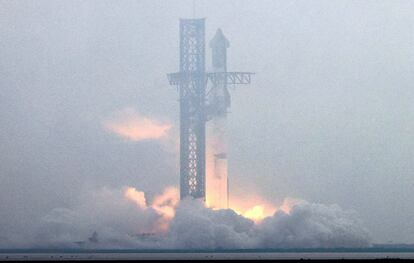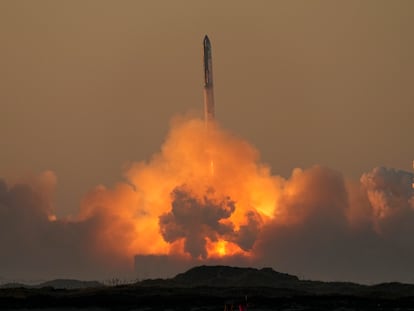Third test flight of SpaceX’s mega rocket ends with loss of spacecraft
The company said it lost contact with Starship as it neared its goal, a splashdown in the Indian Ocean. It outperformed the previous two test flights

SpaceX’s mega rocket blasted off on another test flight Thursday and made it farther than two previous attempts, but the spacecraft was lost as it descended back to Earth.
The company said it lost contact with the spacecraft as it neared its goal, a splashdown in the Indian Ocean, about an hour after liftoff from the southern tip of Texas near the Mexican border.
It outperformed the previous two test flights, which both ended in explosions minutes after liftoff. Minutes later, the booster separated seamlessly from the spaceship and splashed down into the gulf. The spacecraft continued eastward for a planned hourlong flight and splashdown in the Indian Ocean.
Starship, the biggest and most powerful rocket ever built, soared from the southern tip of Texas near the Mexican border before it headed out over the Gulf of Mexico. No people or satellites were on board.
An hour later, SpaceX commentators said contact had been lost with the spacecraft. “The ship has been lost. So no splashdown today,” said SpaceX’s Dan Huot. “But again, it’s incredible to see how much further we got this time around.”
The rocket and futuristic-looking spacecraft towers 397 feet (121 meters), easily exceeding NASA’s past and present moon rockets.
SpaceX’s Elon Musk congratulated his team. ”SpaceX has come a long way,” Musk said via X, former Twitter. The rocket company was founded exactly 22 years ago Thursday.
NASA watched with keen interest: The space agency needs Starship to succeed in order to land astronauts on the moon in the next two or so years. This new crop of moonwalkers — the first since last century’s Apollo program — will descend to the lunar surface in a Starship, at least the first couple times.
Sign up for our weekly newsletter to get more English-language news coverage from EL PAÍS USA Edition
Tu suscripción se está usando en otro dispositivo
¿Quieres añadir otro usuario a tu suscripción?
Si continúas leyendo en este dispositivo, no se podrá leer en el otro.
FlechaTu suscripción se está usando en otro dispositivo y solo puedes acceder a EL PAÍS desde un dispositivo a la vez.
Si quieres compartir tu cuenta, cambia tu suscripción a la modalidad Premium, así podrás añadir otro usuario. Cada uno accederá con su propia cuenta de email, lo que os permitirá personalizar vuestra experiencia en EL PAÍS.
¿Tienes una suscripción de empresa? Accede aquí para contratar más cuentas.
En el caso de no saber quién está usando tu cuenta, te recomendamos cambiar tu contraseña aquí.
Si decides continuar compartiendo tu cuenta, este mensaje se mostrará en tu dispositivo y en el de la otra persona que está usando tu cuenta de forma indefinida, afectando a tu experiencia de lectura. Puedes consultar aquí los términos y condiciones de la suscripción digital.
More information
Archived In
Últimas noticias
EU’s prestige at stake with proposal to fund Ukrainian war effort with Russian assets
Mustafa Suleyman: ‘Controlling AI is the challenge of our time’
Venezuela breaks energy agreements with Trinidad and Tobago due to alleged complicity with the US
The murder of Michele and Rob Reiner: A tale of horrific days in Hollywood
Most viewed
- ‘El Limones’ and the growing union disguise of Mexican organized crime
- Christian Louboutin: ‘Young people don’t want to be like their parents. And if their parents wear sneakers, they’re going to look for something else’
- ‘We are dying’: Cuba sinks into a health crisis amid medicine shortages and misdiagnosis
- A mountaineer, accused of manslaughter for the death of his partner during a climb: He silenced his phone and refused a helicopter rescue
- The low-cost creative revolution: How technology is making art accessible to everyone










































